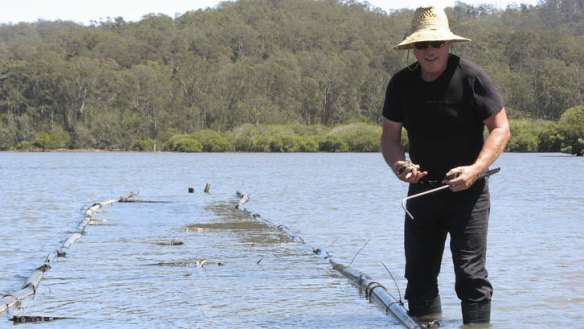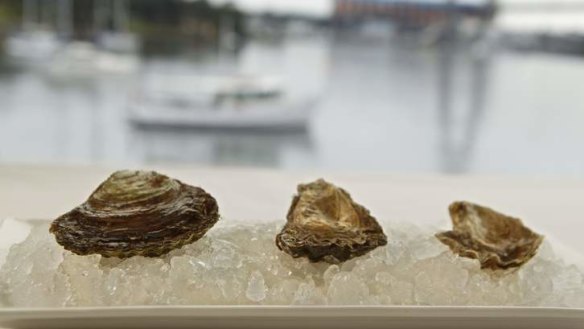Piquepoul and the oyster man
Pairing wine with fresh-shucked oysters can be a challenge, but a local lover of both may have the answer, <b>Chris Shanahan</b> writes.

This story of oysters and wine links France's Provencale coast to Batemans Bay, half a world away, and to Cowra, on the warm floor of the west-flowing Lachlan River.
The man joining the dots is Steve Feletti, owner of Moonlight Flat Oysters at Batemans Bay. He borrows the language of wine: Just like premium wine and cheese, he says, "oysters reflect their context of finish and provenance with a unique flavour profile".
Feletti recommends wines that "balance the saline strength of our structured rock oyster brands" and "smoky finish end palate of the angasi". Feletti's eclectic list includes a chardonnay from Orange, NSW, and a chardonnay, a gewurztraminer and a cortese (an Italian variety) from Victoria's Yarra Valley, Mansfield and Mount Tallarook, respectively. The limited list suggests Feletti finds few wines that really do the trick with oysters.

But during a 2008 French tour, Feletti tasted picpoul de pinet with oysters farmed nearby on the Languedoc coast. "No single wine rang my bells up until this experience," he says.
For the locals, the bells rang centuries ago, Feletti says. Today, wine producers within the picpoul de pinet appellation promote their acidic young white under the slogan: son terroir, c'est la mer (its territory is the sea) - with images of wine, oysters and the sea.
The picpoul de pinet appellation stretches from Pezenas, in the hinterland, southeast to Sete on the Mediterranean. The region's white grape variety, officially piquepoul blanc, produces acidic, lemony, dry whites - its high acidity the key to a successful pairing with oysters.
But piquepoul blanc remains a small-scale specialty, with French plantings totalling just 1455 hectares in 2009.
Two years after discovering piquepoul, Feletti asked French grape grower Guy Bascou for vine cuttings to take back to Australia. Bascou obliged, and after three years in quarantine, the cuttings arrived in Cowra, where Feletti owns a farm.
Shortly after, the local state member and Minister for Primary Industries, Katrina Hodgkinson, planted what Feletti believes to be Australia's first piquepoul vine.
Feletti intends to follow this symbolic planting with a commercial venture in August, establishing 1000 vines on the O'Dea family's nearby Windowrie vineyard. He expects second-generation viticulturist Jason O'Dea to oversee the first vintage as early as 2015. We should then taste the first Australian piquepoul some months later, under the Borrowed Cuttings label.
Feletti hopes in future to establish vines on the south coast and, over time, establish piquepoul as "part of the oyster experience", much as French vignerons and oyster farmers have done for centuries. He agrees with one US description of the variety as "the default wine for oysters" as it forms a "backdrop, allowing the oyster to shine", he says.
Feletti's idea of oysters, though, may not be the same as those of us who belt down the coast for the weekend, picking up a hessian bagful from Batemans Bay, Tuross Head, Narooma or wherever.
He raises flat (angasi) and cupped (Sydney rock) oysters year round in the Clyde River, near Batemans Bay. He sells most, under his patented brands, including Clair de Lune, to restaurants - where they sell at about $7 each. Feletti says he finishes each brand differently in response to different markets.
They're not in any Canberra restaurants. But where you do find them - for example, at Sydney's Boathouse on Blackwattle Bay - they'll be shucked on demand by trained staff. And in the years ahead they'll no doubt be served with Feletti's piquepoul.
Feletti says he sells to between 20 and 40 restaurants in long-term partnerships. He expects restaurants "to do something for my brand" and, in return, he provides staff training, as well as a year-round supply of succulent oysters. He also writes a regular newsletter and conducts master classes for consumers - all in the cause of better appreciation of live, shucked-on-demand oysters.
This is a far cry from popular consumption; or indeed of heroic efforts like those of Henry IV, who reputedly swallowed 300 oysters before dinner; or of a customer of Brillat-Savarin's 32-dozen pre-dinner snack.
In my own experience, the strong seaside flavours of oysters overwhelm many wines. But I've found several up to the task over the years, each in it own way. At a little cafe in the dunes of Cap Ferret (near Bordeaux), a tart, fairly neutral young Muscadet de Sevre et Maine, from the Loire Valley, refreshed the mouth but allowed the briny, oyster flavours to sing.
Years later, in Bordeaux, a local, partially oak-fermented semillon sauvignon blanc blend sat happily with plump, juicy, ice-cold oysters.
On many occasions, young chablis (cold-climate French chardonnay) proved itself perhaps the most reliable of all oyster wines. Its high acidity, desert dryness and subtle flavour easily balanced the saline, iodine-like twang of the oyster. To date, this is my favourite oyster match-up. Costco, Dan Murphy’s and First Choice all offer inexpensive imports from the region.
And one Australian riesling remains in the memory – a success of wine, oyster, location and occasion. On a cold, rainy dusk at the Steingarten vineyard, Eden Valley, huddled under umbrellas, we ate fresh-shucked Coffin Bay oysters with wine from the vineyard we stood in. Steingarten Riesling 2007’s brisk lime-like flavour simply replaced the traditional squeeze of lime.
Amanda Yallop, chief sommelier at Sydney’s outstanding Quay restaurant, leans more towards high acid, savoury-to-neutral whites. She says in the days when Quay offered oysters, she recommended aromatic young whites, including riesling, and also champagne, which she sees as a classic match for its tangy, zesty finish.
Owner of Canberra’s Mezzalira and Italian and Sons restaurants Pasquale Trimboli says his customers have moved from dry whites to prosecco – a fresh but neutral sparkler that offers a refreshing backdrop to the briny oyster flavour. Trimboli currently sells Sydney rock oysters from Pambula, but rates Feletti’s oysters “the best I’ve ever tasted in Australia”, and hopes to offer them in future.
He has been in discussions with Feletti for some time and says Feletti “is very fussy about storage and service”.
But matching wine with oysters isn’t a science and oysters, like personal taste, vary widely. Piquepoul can only add to the choice. Tim Stock’s Vinous Imports offers picpoul de pinet from Chateau Petit Roubie, though he’s sold out at present.
And Randall Pollard’s Heart and Soil Imports, Melbourne, offers Domaine de la Madone 2011 for $24 (0408 432 456). Feletti sells Moonlight Flat oysters live by courier to Canberra customers (info@moonlightflatoysters.com.au).
Chris Shanahan is a wine and beer judge, former liquor retailer and freelance wine writer.